Introduction
Here are some examples of exercises for you to try. The exercises may be suggested for a condition or for rehabilitation. Start each exercise slowly. Ease off the exercises if you start to have pain.
You will be told when to start these exercises and which ones will work best for you.
How to do the exercises
Single knee-to-chest stretch
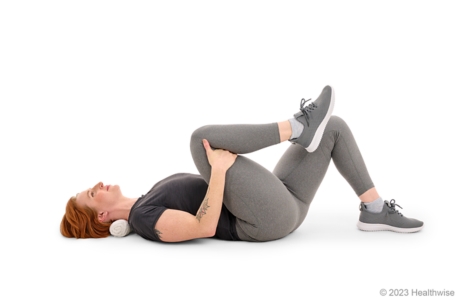
- Lie on your back with your knees bent and your feet flat on the floor. You can put a small pillow under your head and neck if it is more comfortable.
- Clasp your hands under one knee and bring the knee to your chest. Keep your other foot flat on the floor.
- Keep your lower back pressed to the floor. Hold the stretch for at least 15 to 30 seconds.
- Relax and lower the knee to the starting position.
- Repeat 2 to 4 times with each leg.
To get more stretch, put your other leg flat on the floor while pulling your knee to your chest.
Bridging (feet flat)
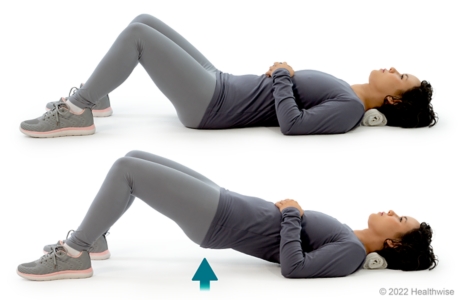
- Lie on your back with both knees bent and your feet flat on the floor. Your knees should be bent about 90 degrees.
- Tighten your belly muscles by pulling your belly button in toward your spine. Keep breathing normally and don't hold your breath.
- Push your feet into the floor, squeeze your buttocks, and lift your hips off the floor until your shoulders, hips, and knees are all in a straight line. Keep your hips level.
- Hold for about 6 seconds.
- Slowly lower your hips back to the floor.
- Repeat 8 to 12 times.
Alternate arm and leg (bird dog)
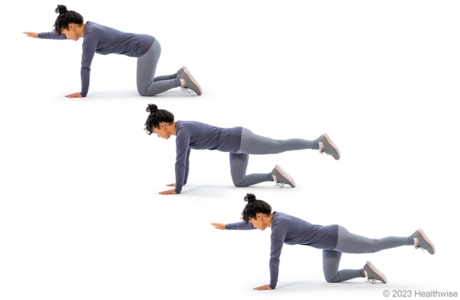
- Start on the floor, on your hands and knees.
- Tighten your belly muscles by pulling your belly button in toward your spine. Be sure you continue to breathe normally and do not hold your breath.
- Keeping your back and neck straight, raise one arm off the floor and hold it straight out in front of you. Be careful not to let your shoulder drop down, because that will twist your trunk.
- Hold for about 6 seconds, then lower your arm and switch to your other arm. Over time, work up to holding for 10 to 30 seconds each time.
- Repeat 8 to 12 times with each arm.
When you feel steady and strong doing this exercise with your arms, try doing the exercise with your legs instead. Raise one leg and hold it straight out behind you. Be careful not to let your hip drop down, because that will twist your trunk.
When holding your leg straight out becomes easier, try raising your opposite arm at the same time.
Clamshell for back problems
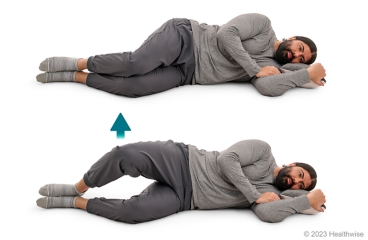
- Lie on your side with a pillow under your head. Keep your feet and knees together and your knees bent.
- Raise your top knee, but keep your feet together. Do not let your hips roll back. Your legs should open up like a clamshell.
- Hold for about 6 seconds.
- Slowly lower your knee back down.
- Repeat 8 to 12 times.
- Switch to your other side and repeat the steps.
Hamstring stretch in a doorway
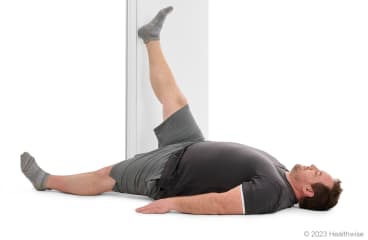
- Sit on the floor close to a doorway. Be sure to stretch your affected leg first.
- Lie down with your other leg through the doorway.
- Slide your affected leg up the wall to straighten your knee. Don't point your toes. You should feel a gentle stretch down the back of your leg. Be sure to:
- Hold the stretch for at least 1 minute. Then over time, try to lengthen the time you hold the stretch to as long as 6 minutes.
- Repeat 2 to 4 times.
- It's a good idea to repeat these steps with your other leg.
- To stretch your right leg, scoot to the right side of the doorway.
- To stretch your left leg, scoot to the left side of the doorway.
- Keep both knees straight.
- Keep your back flat and your other heel on the floor.
If you do not have a place to do this exercise in a doorway, there is another way to do it:
- Lie on your back, and bend the knee of your affected leg.
- Loop a towel under the ball and toes of that foot, and hold the ends of the towel in your hands.
- Straighten your knee as you raise that foot into the air. Slowly pull back on the towel. You should feel a gentle stretch down the back of your leg.
- Hold the stretch for 15 to 30 seconds. Or even better, hold the stretch for 1 minute if you can.
- Repeat 2 to 4 times.
- It's a good idea to repeat these steps with your other leg.
Lower abdominal strengthening
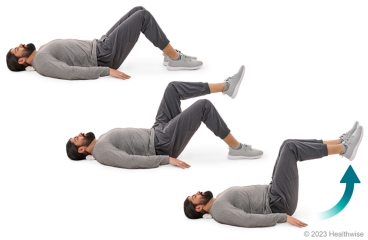
- Lie on your back with your knees bent and your feet flat on the floor.
- Tighten your belly muscles by pulling your belly button in toward your spine. Keep breathing normally and don't hold your breath.
- Lift one foot off the floor and bring your knee toward your chest, so that your knee is straight above your hip and your leg is bent like the letter "L."
- Lift the other knee up to the same position.
- Lower one leg at a time to the starting position.
- Keep alternating legs until you have lifted each leg 8 to 12 times.
Keep your belly muscles tight and your back still as you are moving your legs. Keep breathing normally.
Piriformis stretch (from legs straight)

- Lie on your back with your legs straight.
- Lift your affected leg and bend your knee. With your opposite hand, gently pull your knee toward your opposite shoulder. You should feel the stretch in your buttock and hip.
- Hold the stretch for 15 to 30 seconds.
- Repeat 2 to 4 times.
- It's a good idea to repeat these steps with your other leg.
Current as of: July 17, 2023
Author: Healthwise Staff
Clinical Review Board
All Healthwise education is reviewed by a team that includes physicians, nurses, advanced practitioners, registered dieticians, and other healthcare professionals.

